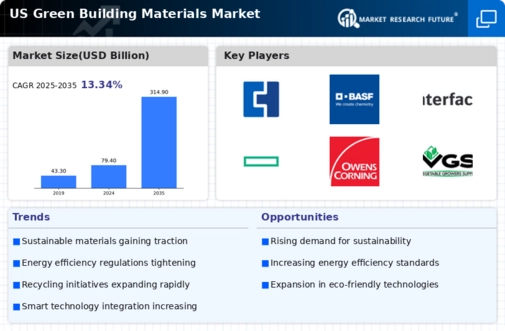Rising Consumer Awareness
The green building-materials market is experiencing a notable shift as consumer awareness regarding environmental sustainability increases. Homeowners and businesses are becoming more informed about the benefits of using eco-friendly materials, which is driving demand. According to recent surveys, approximately 70% of consumers express a preference for sustainable building options. This heightened awareness is influencing purchasing decisions, leading to a greater emphasis on products that minimize environmental impact. As a result, manufacturers are compelled to innovate and offer a wider range of sustainable materials. This trend not only supports the growth of the green building-materials market but also encourages the development of new technologies and practices that align with consumer values.
Corporate Sustainability Initiatives
Many corporations are increasingly adopting sustainability as a core component of their business strategies. This trend is influencing the green building-materials market, as companies seek to align their operations with environmentally responsible practices. Corporations are investing in green building projects to enhance their brand image and meet consumer expectations. For instance, major companies are committing to using sustainable materials in their construction projects, which is driving demand for eco-friendly products. This corporate shift towards sustainability is expected to bolster the green building-materials market, as businesses recognize the long-term benefits of investing in environmentally friendly practices.
Government Regulations and Standards
The regulatory landscape surrounding construction practices is evolving, with increasing emphasis on sustainability. Government agencies are implementing stricter building codes and standards that promote the use of green materials. For example, the adoption of LEED certification has become a benchmark for sustainable building practices in the US. These regulations not only encourage the use of eco-friendly materials but also provide incentives for builders and developers to comply. As a result, the green building-materials market is likely to benefit from this regulatory push, as compliance with these standards often necessitates the use of sustainable products. This trend is expected to drive market growth as more projects seek certification and adhere to environmentally responsible practices.
Economic Incentives for Sustainable Construction
Economic factors play a crucial role in the growth of the green building-materials market. Financial incentives, such as tax credits and grants for sustainable building projects, are encouraging developers to invest in eco-friendly materials. The US government has introduced various programs aimed at promoting energy-efficient construction, which often includes the use of green materials. These incentives can significantly reduce the overall cost of construction, making it more appealing for builders to adopt sustainable practices. As a result, the green building-materials market is likely to see increased investment and growth, as more stakeholders recognize the financial benefits associated with sustainable construction.
Technological Advancements in Material Production
Innovations in material science are significantly impacting the green building-materials market. Advances in production techniques, such as 3D printing and bio-based materials, are enabling the creation of sustainable products that were previously unattainable. For instance, the use of mycelium and other organic materials is gaining traction, offering alternatives to traditional building materials. These technologies not only reduce waste but also lower the carbon footprint associated with construction. The market is projected to grow at a CAGR of 12% over the next five years, driven by these technological advancements. As manufacturers adopt these innovative practices, the green building-materials market is likely to expand, providing consumers with more options for sustainable construction.





















Leave a Comment